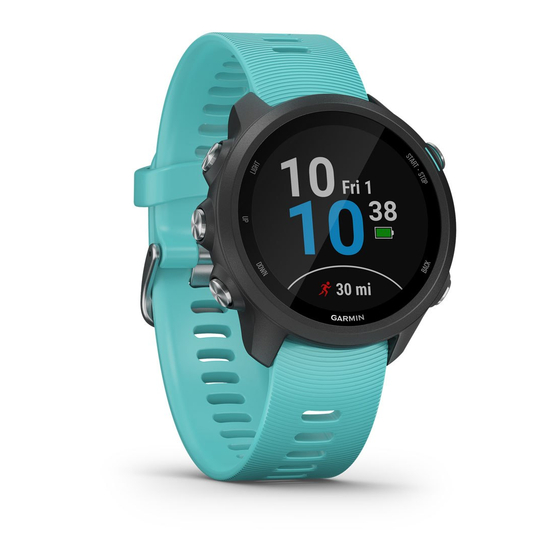Garmin FORERUNNER 245 MUSIC Посібник користувача - Сторінка 16
Переглянути онлайн або завантажити pdf Посібник користувача для Дивись. Garmin FORERUNNER 245 MUSIC. Garmin FORERUNNER 245 MUSIC 40 сторінок.

Turning Off the Wrist-based Heart Rate Monitor
The default value for the Wrist Heart Rate setting is Auto. The
device automatically uses the wrist-based heart rate monitor
unless you pair an ANT+ heart rate monitor to the device.
NOTE: Disabling the wrist-based heart rate monitor also
disables the wrist-based pulse oximeter sensor.
1
From the heart rate widget, hold UP.
2
Select Options > Status > Off.
Running Dynamics
You can use the pod with your compatible device to provide
real-time feedback about your running form. The pod has an
accelerometer that measures torso movement in order to
calculate six running metrics.
NOTE: The running dynamics features are available on only
some Garmin devices.
Cadence: Cadence is the number of steps per minute. It
displays the total steps (right and left combined).
Vertical oscillation: Vertical oscillation is your bounce while
running. It displays the vertical motion of your torso,
measured in centimeters for each step.
Ground contact time: Ground contact time is the amount of
time in each step that you spend on the ground while
running. It is measured in milliseconds.
NOTE: Ground contact time and balance are not available
while walking.
Ground contact time balance: Ground contact time balance
displays the left/right balance of your ground contact time
while running. It displays a percentage. For example, 53.2
with an arrow pointing left or right.
Stride length: Stride length is the length of your stride from one
footfall to the next. It is measured in meters.
Vertical ratio: Vertical ratio is the ratio of vertical oscillation to
stride length. It displays a percentage. A lower number
typically indicates better running form.
Color Gauges and Running Dynamics Data
The running dynamics screens display a color gauge for the primary metric. You can display cadence, vertical oscillation, ground
contact time, ground contact time balance, or vertical ratio as the primary metric. The color gauge shows you how your running
dynamics data compare to those of other runners. The color zones are based on percentiles.
Garmin has researched many runners of all different levels. The data values in the red or orange zones are typical for less
experienced or slower runners. The data values in the green, blue, or purple zones are typical for more experienced or faster
runners. More experienced runners tend to exhibit shorter ground contact times, lower vertical oscillation, lower vertical ratio, and
higher cadence than less experienced runners. However, taller runners typically have slightly slower cadences, longer strides, and
slightly higher vertical oscillation. Vertical ratio is your vertical oscillation divided by stride length. It is not correlated with height.
Go to
www.garmin.com/runningdynamics
running dynamics data, you can search reputable running publications and websites.
Color Zone Percentile in Zone Cadence Range Ground Contact Time Range
Purple
>95
Blue
70–95
Green
30–69
Orange 5–29
Red
<5
Ground Contact Time Balance Data
Ground contact time balance measures your running symmetry and appears as a percentage of your total ground contact time. For
example, 51.3% with an arrow pointing left indicates the runner is spending more time on the ground when on the left foot. If your
data screen displays both numbers, for example 48–52, 48% is the left foot and 52% is the right foot.
Color Zone
Symmetry
Percent of Other Runners
Ground Contact Time Balance >52.2% L 50.8–52.2% L 50.7% L–50.7% R 50.8–52.2% R >52.2% R
12
for more information on running dynamics. For additional theories and interpretations of
>183 spm
<218 ms
174–183 spm
218–248 ms
164–173 spm
249–277 ms
153–163 spm
278–308 ms
<153 spm
>308 ms
Red
Orange
Poor
Fair
Good
5%
25%
40%
Training with Running Dynamics
Before you can view running dynamics, you must put on the
HRM-Run
™
accessory, HRM-Tri
Dynamics Pod, and pair it with your device
Wireless Sensors, page
If your Forerunner was packaged with the heart rate monitor, the
devices are already paired, and the Forerunner is set to display
running dynamics.
1
Select START, and select a running activity.
2
Select START.
3
Go for a run.
4
Scroll to the running dynamics screens to view your metrics.
5
If necessary, hold UP to edit how the running dynamics data
appears.
Green
Orange
Fair
25%
™
accessory, or Running
21).
Red
Poor
5%
(Pairing Your
Heart Rate Features
